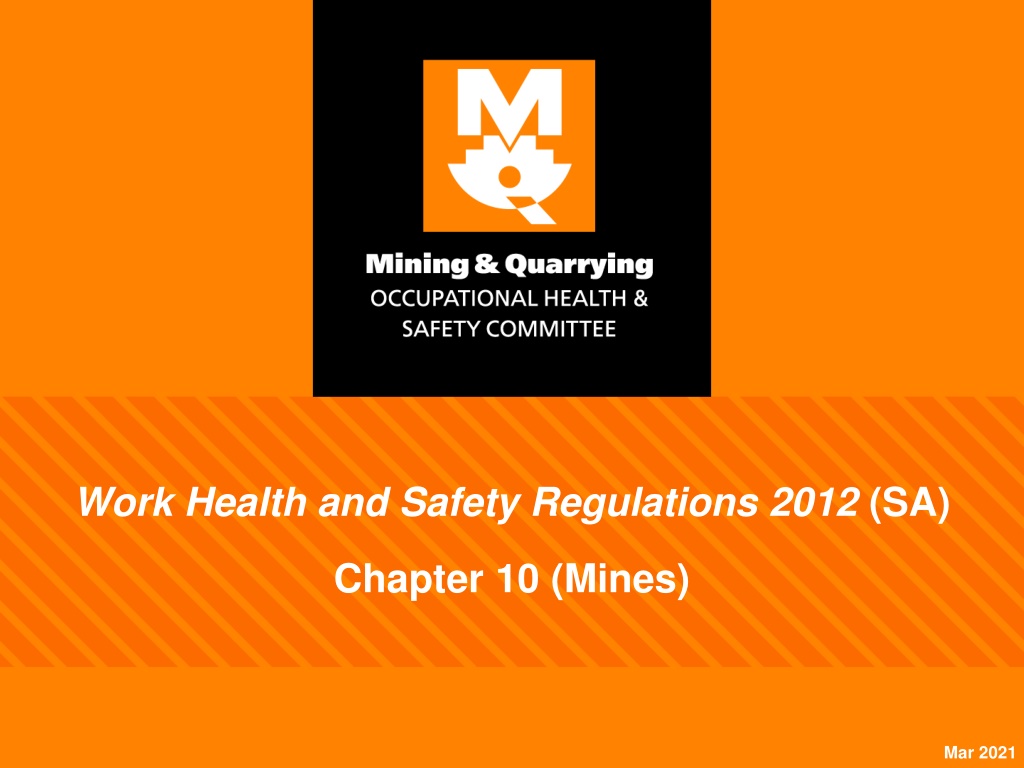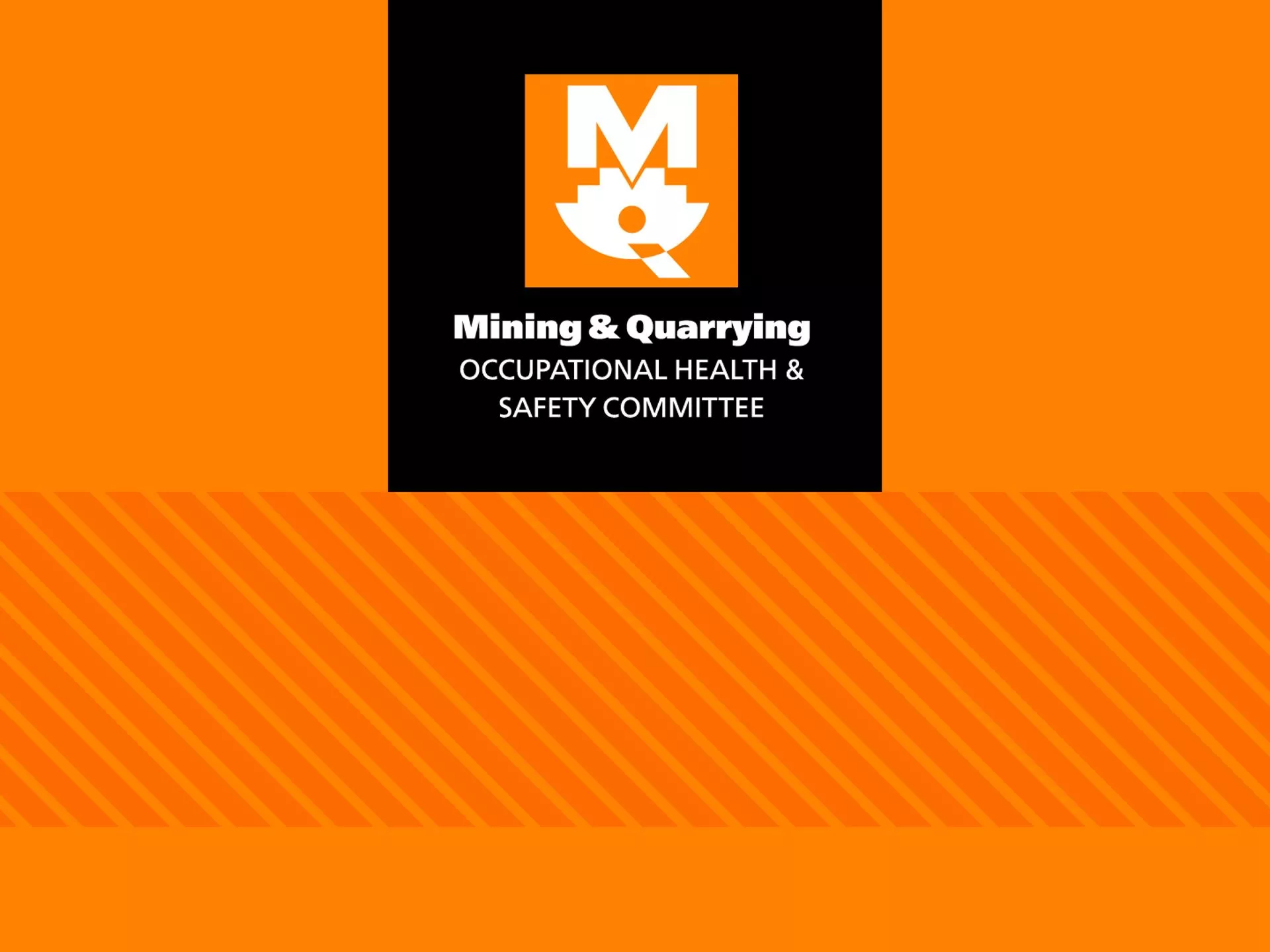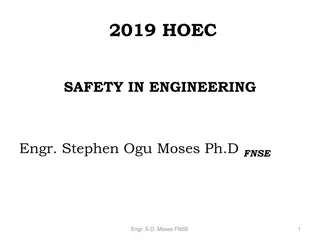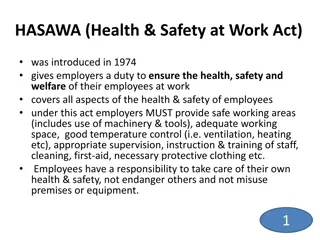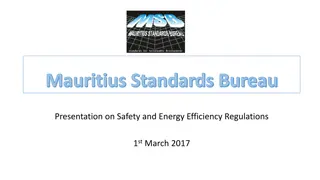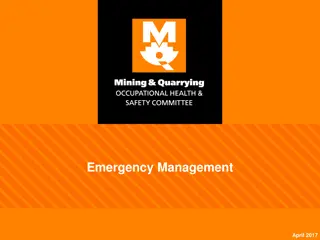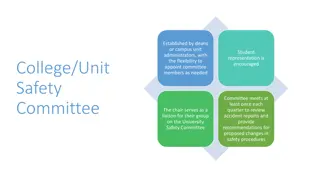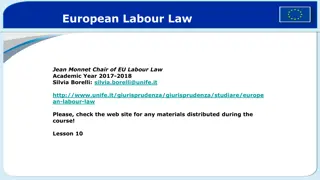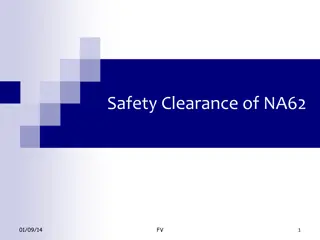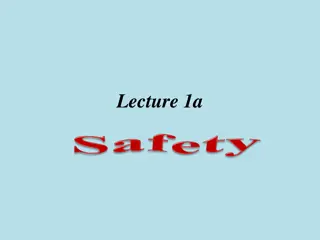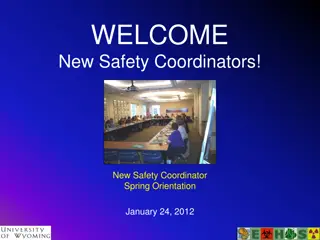Work Health and Safety Regulations 2012 (SA) Chapter 10 Overview
The Work Health and Safety Regulations 2012 (SA) Chapter 10, specifically for mines, came into effect in South Australia in 2014. These regulations outline requirements specific to mining and quarrying activities, emphasizing the implementation of a Safety Management System to manage risks effectively. The Safety Management System covers policies, management structures, contractor management, and hazard control measures tailored to each operation's complexity.
Download Presentation

Please find below an Image/Link to download the presentation.
The content on the website is provided AS IS for your information and personal use only. It may not be sold, licensed, or shared on other websites without obtaining consent from the author. Download presentation by click this link. If you encounter any issues during the download, it is possible that the publisher has removed the file from their server.
E N D
Presentation Transcript
Work Health and Safety Regulations 2012 (SA) Chapter 10 (Mines) Mar 2021
Disclaimer IMPORTANT:The information in this presentation is of a general nature, and should not be relied upon as individual professional advice. If necessary, legal advice should be obtained from a legal practitioner with expertise in the field of Work Health and Safety law (SA). Although every effort has been made to ensure that the information in this presentation is complete, current and accurate, the Mining and Quarrying Occupational Health and Safety Committee, any agent, author, contributor or the South Australian Government, does not guarantee that it is so, and the Committee accepts no responsibility for any loss, damage or personal injury that may result from the use of any material which is not complete, current and accurate. Users should always verify historical material by making and relying upon their own separate inquiries prior to making any important decisions or taking any action on the basis of this information. 2
Creative Commons This work is licenced under Creative Commons Attribution Non Commercial 4.0 International Licence. The licence is available to view at http://creativecommons.org/licenses/by-nc/4.0/ This creative commons licence allows you to copy, communicate and adapt the work for non-commercial purposes, as long as you attribute the work to Mining and Quarrying Occupational Health and Safety Committee and abide by all the other licence terms therein. ISBN 978-1-925361-43-8 3
Introduction New Work Health and Safety (WHS) Mines Regulations (Chapter 10) came into effect in South Australia on 1 January 2014. The Mines Regulations are part of the broader WHS Regulations 2012 (SA) and operate in addition to the obligations that apply to all workplaces. The Mines Regulations contain requirements that are specific to mining and quarrying activities. Most of these requirements will be familiar to the mining and quarrying industry and existing safety arrangements will in many cases comply with the new requirements. The most obvious difference to the previous regulations is the requirement for a documented Safety Management System. This requirement for a Safety Management System provides the basis for managing all risks to health and safety associated with mining and quarrying. 4
Introduction The Safety Management System describes such things as: policies, management structures, contractor management arrangements and importantly hazard and risk control measures, encompassing principal mining hazards. The regulations recognise that not all mines and quarries are the same and as such the detail contained in the management system will depend on the nature and complexity of the operation. 5
Mines Regulations - Key Elements Mine & Mining Operations; Mine Holder / Mine Operator primary duty holder; Mine Manager and competencies; Managing risks; control of risk safety management system principal mining hazards operational controls all mines and underground specific emergency management information instruction and training 6
Mines Regulations - Key Elements Mine survey plan; Safety role for workers; Mines specific notifications; Mine record; and National Mine Safety Database (NMSD) quarterly reporting. 7
A Mine The WHS Regulations 2012 (SA), define a mine as: Any workplace at which mining operations are carried out; or A tourist mine; and Any fixtures, fittings, plant or structures at the place that are used or were formerly used for mining operations. A tourist mine is defined as a workplace: used only for tourism purposes but at which mining operations were formerly carried out; and at which there is a principal mining hazard that was present at the workplace when the mining operations were carried out. An underground mine means that part of a mine that is beneath the surface of the earth and includes plant and structures that extend continuously from the surface into that part of the mine. 8
Mining Operations Mining operations include activities carried out for the purpose of: Extracting minerals from, or injecting minerals into the ground, and Exploring for minerals by mechanical means that disturb the ground, and Activities carried out in connection with mining activities at a site, or at a site adjoining or in the vicinity of a site, at which the mining activities are carried out. Mining activities include: Handling, storing, preparing or processing extracted materials; Constructing a site or at a site adjoining where a mining activity is carried out; Activities associated with decommissioning, making safe or closure of an extraction site or exploration site; and Educational and tourist activities carried out at a site, or at a site adjoining or in the vicinity of a site, at which the mining activities are carried out. 9
Mining Operations Mining operations do not include: An activity carried out in relation to the extraction of minerals on private land for the private, and non-commercial use of the owner of the land; Fossicking; and Any activity where the extraction of minerals is incidental to the activity. Example - Civil works such as tunnelling to create a road. 10
Mine Holder / Mine Operator The Mine Holder of a mine: Is the Mine Operator unless they appoint another PCBU to be the Mine Operator; and The PCBU with control over a right or entitlement to carry out mining operations at the mine (primary duty holder). 11
Mine Operator Appointment The Mine Holder of a mine, may only appoint a person to be the Mine Operator if: The person is conducting a business or undertaking; and Is appointed in accordance with R615 to carry out mining operations at the mine on behalf of the Mine Holder; and The Mine Holder authorises the person to have management or control of the mine and to discharge the duties of a Mine Operator under the Act & Regulations. 12
Mine Operator Notification Notification of the Mine Operator (as mine holder or appointed) must be given to regulator before mining operations commence. Notification must be: In writing; and Made in the manner and form required by the regulator. SafeWork SA has provided a form which can be downloaded from their website: Mine Holder or Mine Operator Appointment and notification form. 13
Mine Manager Appointment A mine operator must ensure: A competent person is appointed to be Mine Manager of a mine where mining operations are carried out; and The Mine Manager holds the relevant competencies (general / prescribed) requirements to be a Mine Manager. Note: This does not apply in respect of mining operations carried out at a tourist mine, an exploration site or a precious stones field under the Opal Mining Act 1995. 14
Mine Manager Appointment A Mine Operator who is competent to be a Mine Manager in relation to the mine, may be appointed as Mine Manager. However, a Mine Operator must not, unless permitted to do so in accordance with a determination by the regulator, appoint a Mine Manager of a mine, if the mine manager is a also a mine manager of a another mine. Note: There is nothing preventing more than 1 person being appointed as a mine manager to cover temporary absences of the mine manager. 15
Mine Manager Competencies Underground Mine or Quarry less than 20 workers General competency requirements only. No prescribed experience or qualifications defined. Underground Mine or Quarry with 20 or more workers General competency requirements; and Prescribed experience and qualifications. 16
Mine Manager Competencies General competencies all Mine Managers A Mine Operator, in appointing a person to be a manager of a underground mine or quarry, must be satisfied that the person: Has the relevant training, qualifications, experience, knowledge and skills to manage and supervise the mining operations carried out at the mine; and Has knowledge of the requirements of the WHS Act 2012 (SA) and the WHS Regulations 2012 (SA), particularly Chapter 10; and Is capable of managing hazards at the mine. 17
Mine Manager Competencies General competencies all Mine Managers Mine Operators, in satisfying themselves that a person has knowledge of the WHS Act and the WHS Regulations (including Chapter 10): People that have previously passed the mining law exam for their mine/quarry manager certification as having sufficient knowledge; or Must individually assess any person who has not passed this exam to determine if they have sufficient knowledge. For example, a Mine Operator develops an assessment module/adopt an industry module on WHS legislation. 18
Mine Manager Competencies Prescribed Competencies 20 or more workers A Mine Operator, in appointing a person to be a Mine Manager of an underground mine or quarry with 20 or workers, must be satisfied that the person: Has the general competency requirements to be a Mine Manager; and Meets any applicable prescribed competency requirements (experience and qualifications) to be a Mine Manager. 19
Mine Manager Competencies Experience - Quarry with 20 or more workers The person to be appointed as a Mine Manager must have at least: 3 years practical experience in quarrying, during which the person had: i. 1 year quarrying operational experience; and ii. experience supervising quarry operations. Qualifications - Quarry with 20 or more workers The person to be appointed as a Mine Manager: Holds a degree in mining engineering or diploma in surface operations management from a university or tertiary institution in Australia; or An equivalent institution as determined by the regulator. 20
Mine Manager Competencies Experience - Underground with 20 or more workers The person to be appointed as a Mine Manager has at least: 5 years working at a mine; and At least 3 of those years, spent working at an underground mine during which the person had: i. 2 years underground mining operational experience; and ii. experience supervising underground mining operations. Qualifications - Underground with 20 or more workers The person to be appointed as a Mine Manager: Holds a degree or diploma in mining engineering from a university or tertiary institution in Australia; or An equivalent institution as determined by the regulator. 21
Calculating the Number of Workers The regulators position on calculating the number of workers at a mine or quarry for determining the applicable Mine Manager competencies is the following: The number of workers in a 24 hour period under a mine s normal operations, including contractors. Note: During shutdowns and major construction projects, any additional workers engaged in this period are not included in the calculation of number of workers. 22
Calculating the Number of Workers Additionally, a Mine Operator, if they choose, can divide the mine site into operational areas, such as: Processing; Surface mining; Underground mining; Concrete batching plants; Maintenance workshops; and Waste transfer stations etc. The Mine Operator can then calculate the number of workers within those activities and appoint a manager as required. 23
Mine Manager Records A Mine Operator must ensure a record is kept: Of the appointment of each Mine Manager to a mine; Of any information provided to the Mine Operator by a Mine Manager, in satisfaction of the mine managers competency requirements; and For the duration of the person's appointment as a Mine Manager, and for at least 2 years after the person ceases to be a Mine Manager at the mine. 24
Control of Risk A PCBU at a mine, must manage risks to health and safety associated with mining operations, and in doing so must ensure a risk assessment is conducted by a competent person. In conducting a risk assessment, the person must have regard to: The nature of the hazard; and The likelihood of the hazard affecting the health or safety of a person; and The severity of the potential health and safety consequences. 25
Control of Risk A PCBU at a mine must review, and as necessary, revise control measures implemented to manage risks, if: An audit of the effectiveness of the SMS for the mine indicates a deficiency in a control measure; or A worker is moved from a hazard or assigned to different work in response to a recommendation contained in a health monitoring report; or A notifiable incident or mining incident occurs; or A health and safety representative requests a review of a control measure. 26
Control of Risk A Mine Operator who has reviewed a control measure under R38, in relation to notifiable incident or mining incidents must keep a record of certain reviews of control measures. A record of the following must be kept: Work health and safety issues arising form the incident; Recommendations arising from consideration of the incident; and Summary of any changes to the safety management system and any affected principal mining hazard management plan for the mine. 27
Control of Risk A PCBU at a mine other than the Mine Operator, who has reviewed a control measure under R38, in relation to notifiable incident or mining incidents, must keep a record of the following: Work health and safety issues arising form the incident; and Recommendations arising from consideration of the incident. 28
Safety Management Systems for Mines Under the WHS Regulations 2012 (SA), R.621 - Duty to Establish and Implement Safety Management System (SMS) Documented readily available & understandable Used as primary means of ensuring health & safety or workers & others Part of overall management system Contents as specified in 622 Appropriate to nature & complexity of the mine Maintained to ensure effectiveness Reviewed at least every 3 years & sooner to remain effective Comprehensive & integrated Safety Sufficient to refer to a plan/ document if already addressed Mine operator must establish & implement an SMS Management System R.621 29
Safety Management Systems for Mines Under the WHS Regulations 2012 (SA), R.622 - Content of Safety Management System Principal Mining Hazard Management Plans Ventilation Control Plan & Ventilation Plan Specific Control Measures Mine Survey Plan Withdrawal situations Emergency Plan Notifications Worker & Contractor Management Risk Management Safety Performance Standards & Audit Health & Safety Policy Management System 30
Principal Mining Hazards Regulation 612 of the WHS Regulations 2012 (SA), defines a Principal Mining Hazard (PMH) as: Any activity; Process; Procedure; Plant; Structure; Substance; Situation; or Other circumstance relating to the carrying out of mining operations that has a reasonable potential to result in multiple deaths in a single incident or a series of recurring incidents. 31
Principal Mining Hazards As listed in the WHS Regulations 2012 (SA), a PMH can be in relation to, but not limited to, any of the following: Ground or strata failure; Inundation or inrush of any substance; Mine shafts and winding operations; Roads or other vehicle operating areas; Air quality, dust and other airborne contaminants; Fire or explosion; Gas outbursts; Spontaneous combustion; or A hazard identified by the mine operator of a mine under R34. 32
Principal Mining Hazards The mine operator must: Identify all PMHs at the mine; For each PMH identified, conduct a risk assessment that: involves a comprehensive and systematic investigation and analysis of all aspects of risk to health and safety associated with the PMH; and considers each PMH individually and cumulatively with other hazards at the mine. Develop control measures; Prepare a Principal Mining Hazard Management Plan (PMHMP) for each PMH at the mine, having regard to the matters set out in Schedule 19 (2 extracts of Schedule 19 are provided on the following slides); and Ensure PMHMPs are reviewed and as necessary revised if a risk control measure specified in the plan is revised under regulations 38 or 618. 33
Schedule 19 The following matters must be considered in developing the control measures to manage the risks of ground or strata instability The local hydrogeological environment, including surface and ground water Ground or strata instability The local geological structure The geotechnical characteristics of the rocks and soil, including the effects of time, oxidation and water on rock support and stability; Any natural or induced seismic activity; The location and loadings from existing or proposed mine infrastructure such as waste dumps, tailings storage, haul roads and mine facilities; Proposed and existing mining operations, including the nature and number of excavations, the number and size of permanent or temporary voids or openings, backfilling of mined areas and stopes, abutments, periodic weighting and windblast; Any previously excavated or abandoned workings Proposed blasting activities, including air blast 34
Schedule 19 The following matters must be considered in developing the control measures to manage the risks of air quality, dust and other airborne contaminants Types of dust and other chemical and biological contaminants likely to be in the air from both natural sources, including naturally occurring asbestos, and introduced sources Air Quality, Dust and other Airborne Contaminants The level of oxygen, dust and other contaminants in the natural or supplied air of the mine The temperature and humidity of the air The length of exposure, having regard to extended shifts and reduced recovery periods. 35
Specific Control Measures all mines The Mine Operator must implement specific control measures at all mines including: Communication between outgoing and incoming shifts; Movement of mobile plant; Prohibited uses; Closure, suspension or abandonment of mine; Minimum age to work in mine; and Operational controls. 36
Specific Control Measures all mines Air quality and monitoring incudes: Temperature and moisture content of air; Exposure standards compliance and monitoring; Air monitoring use of devices and signage; and Requirements under WHS Regulation 50 (monitoring & record keeping). Fitness for work includes: Fatigue; and Alcohol and drugs. 37
Emergency Management These requirements are in addition to the requirements under WHS Regulation R43(1). Specific requirements for all mines: Duty to prepare emergency plan; Consultation in preparation of emergency plan; Implementation of emergency plan; Copies to be kept and provided; Resources for emergency plan; Testing of emergency plan; and Review. 38
Emergency Management Specific requirements for underground mines: Emergency exits (includes at least 2 trafficable exits); Safe escape and refuge; Signage for refuges; Self-rescuers; and Personal protective equipment in emergencies. 39
Emergency Management When developing an Emergency management plan, the following items listed in Schedule 22 of the WHS regulations are required to be included: Site and hazard detail; Command structure and site personnel; Notifications; Resources and equipment; and Procedures. 40
Information, Training & Instruction In addition to the requirements under WHS Regulation R39, the mine operator has a duty to and provide information, training and instruction to workers regarding: All hazards associated with their work; Risk control measures, including fatigue & the consumption of alcohol and drugs; The safety management system; The emergency plan; and The safety role for workers in relation to principal mining hazards. 41
Information, Training & Instruction The mine operator has a duty to: Develop and implement induction procedures for workers and contractors at the mine; Provide information & instruction to visitors to ensure they are: informed about risks instructed in health & safety precautions and emergency procedures Review and if necessary revise any information, training and instruction; and Keep records of training. 42
Health Monitoring The Mine Operator of a mine must ensure that health monitoring is provided to a worker of a mine where there is: A significant risk of an adverse effect on the worker's health because of the worker's exposure to a hazard associated with mining; and Valid techniques are available to detect that effect on the worker's health. 43
Health Monitoring In carrying out health monitoring, a PCBU / Mine Operator must: Inform the worker of health monitoring; Engage a registered medical practitioner experienced in health monitoring to supervise / carry out the monitoring; Pay all associated cost; Provide registered medical practitioner with information; Ensure health monitoring report meets WHS regulatory requirements; Obtain / provide a copy of the report to the mine operator and worker, and in specific circumstances, the regulator; and Keep health monitoring records. 44
Safety Role for Workers Regulation 675Q of the WHS Regulation 2012 (SA), Safety role for workers in relation to principal mining hazards states: The Mine Operator of a mine must implement a safety role for the workers at the mine that enables them to contribute to: the identification of principal mining hazards that are relevant to the work that the workers are or will be carrying out; the consideration of control measures for risks associated with principal mining hazards at the mine; and the conduct of a review of a PMH management plan. The Mine Operator of a mine must ensure the safety role for workers is documented in the SMS and communicated to all workers. A simple way of achieving this is to include the safety role in relation to principal mining hazards, into the workers position description or workplace induction. 45
Consultation For the purposes of Section 49 of the WHS Act 2012 (SA), the mine operator must consult with workers in relation to: The development, implementation and review of the safety management system; Risk assessments for PMH management plans; Preparing, testing and review of the emergency plan; Implementation of the workers safety role; and Strategies relating to the consumption of alcohol or drugs and worker fatigue. 46
Contractor Management If a contractor is working or likely to work at a mine or quarry, the Safety Management System (SMS) document for the mine or quarry, must set out the control measures associated with the contractor s work, including: How the contractor's work management system will be integrated with the SMS of the mine/quarry; The process for assessing the contractor s health and safety policies and procedures (including competency requirements) and integrating them into the SMS; and The arrangements for monitoring and evaluating compliance by the contractor with the health and safety requirements of the safety management system. 47
Incident Notification In addition to the notification requirements under Section 38 of the WHS Act 2012 (SA), mine operators also have a duty to notify SafeWork SA of certain incidents including: A high potential incident relates to incidents under Section 37 of the Act, but expanded to include where a person could have been in the vicinity in usual circumstances; Illness or injury that requires medical treatment as defined in Schedule 24 of the Regulations. Schedule 23 of the WHS Regulations 2012 (SA), outlines the information to be included in the notification of a mining incident including details relating to the person injured, incident and consequences of incident. Note: A Dangerous Incident as described in Section 38 of the Act, now includes unplanned loss of control of heavy earthmoving machinery at a mine or quarry. 48
Mine Survey Plan The Mine Operator of a mine must ensure: A detailed survey plan of the mine is prepared by a competent person; and Take all reasonable steps to obtain historical mine surveys. Note: a competent person means: A person who has acquired through training, qualification or experience the knowledge and skills to carry out the task. (WHS Regulation 5) 49
Mine Survey Plan The plan must show the following (if present at the mine): The workings of the mine, including disused workings and bore holes; The location of electrical installations; The location of telephones and other fixed plant associated with the radio and telecommunications systems; Water dams and tailings dams, natural features surrounding the mine; Places for the storage of hydrocarbons or explosives; Points of entry and exit, including emergency exits; and Refuges (in an underground mine). 50
